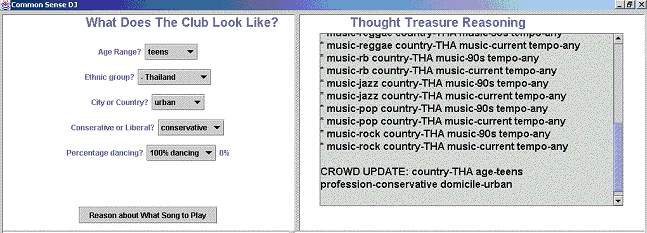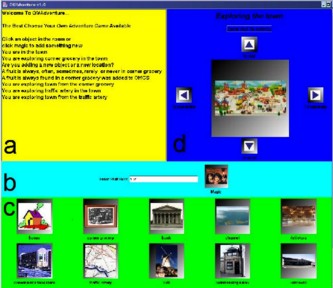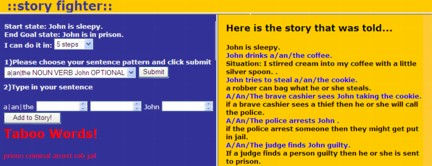
MIT Media Lab Course - Common Sense
Click on the pictures for more information about each project.

People cannot type as fast as they think, especially amid the constraints of mobile devices. There have been numerous approaches to solving this problem, including research in augmented input devices and predictive typing aids. We propose an alternative approach to predictive text entry based on commonsense reasoning. Using OMCSNet, a large-scale semantic network that aggregates and normalizes the contributions made to Open Mind Common Sense (OMCS), our system is able to show significant success in predicting words based on their first three letters. We evaluate this commonsense approach against traditional statistical methods, demonstrating comparable performance, and introduce the possibility of superior performance by combining commonsense and statistical approaches. A mobile phone implementation of the commonsense predictive typing aid demonstrates that such a system could be applied to just about any computing environment.


In this paper, we introduce the Common Sense DJ (CSDJ), a technology to aid DJs in music selection. It uses ThoughtTreasure (TT) as a common sense database to aid in selecting the optimal music for a crowd given certain parameters about the crowd. ThoughtTreasure handles the reasoning aspect and has critics to facilitate in making better decisions. A camera captures the crowds' music response level. The CSDJ responds by going into TT's database finding the necessary common sense knowledge and validating its usefulness through the TT Prover. Given certain goals the application is able to learn. We demonstrate that using common sense database such as ThoughtTreasure we can develop more intelligent applications.
Globuddy is a common sense based application that assists English speaking travelers in communicating in a foreign language. In addition to translating text, Globuddy provides relevant words and phrases for the situation in which the traveler is. Common sense reasoning is done with OMCSNet, a semantic network representation of the Open Mind knowledge. GloBuddy could be easily adapted for use on handheld devices, making it a valuable tool for travelers in foreign countries.
In this paper, I present simulation as an alternative solution to the problem of commonsense knowledge acquisition. This position stems from the fact that commonsense is essentially redundant shared experience over time and posits that reality computer games could be a forum in which computers could gain this shared experience from a human user. The implementation and initial results of a learning program, ThoughtStreams, is shown to have some initial success in predicting commonsensical future events based on past experiences in a simple simulation game environment.

This paper describes the StoryIllustrator system, an application
that lets a user add images to a story. This system uses a large
database of pictures in the web to query images for the nouns
that are present in the story. Whenever the user is not pleased
with the images that are returned from the database, the StoryIllustrator
system facilitates the search of more images that are commonsensically
related to the query. Furthermore, the user can then share their
story by creating a web page of the story with the images s/he
selects, along with common sense knowledge tags as alternate text.
This paper introduces Attribute Affinity Agent (AAA), an interactive user profiling and content recommendation agent that searches for relevant products from Amazon.com's inventory based on a user's demographics information. Each user's interests are represented by a list of concepts, derived from the ontology of the Open Mind Common sense Knowledge base. The concepts are then used to query Amazon for relevant products. The search results are then filtered using contextual keyword matching and recommended to the user.

This paper describes a novel application of the OpenMind Common Sense database. The authors developed an interactive scavenger hunt where players are able to navigate a dynamically generated environment. The map of the world is generated from the OpenMind database and the images of the locations are obtained from the World Wide Web. In addition to acting as a proof-of-concept, the Java application, called OMAdventure, enables users to build on the world and add additional knowledge to the OpenMind database. Future work will attempt to utilize other properties of the OpenMind database to create a more rich and interactive environment.

In this paper, we describe the design and implementation of a game called STORYFIGHTER that uses a system of causal reasoning and common sense database knowledge. The story has a predetermined start state and goal state, and the objective of the user is to alternate telling sentences with STORYFIGHTER to arrive at the goal state within a limited number of steps.An example interaction could be a start state of "John is sleepy", and a goal state of "John is in prison." STORYFIGHTER uses a semantic net of causal predicates to generate response sentences to user inputs. If there are no inferences that can be deduced, then STORYFIGHTER queries the Open Mind Common Sense Database for related common sense data sentences.

There exist several software applications that attempt to
use common sense reasoning to assist users do everyday tasks,
such as schedule their day or write emails. One such program is
ARIA, which relies on the information in OpenMind's common sense
database. However, these applications are only as useful as the
quality of the common sense information with which they are reasoning.
One vast improvement in the area of common sense is to introduce
the idea of context, since much common sense information is only
valid within a certain realm. Thus, the objective of this project
was to improve the quality of the information in OpenMind by adding
context to potentially contextually-ambiguous statements currently
in the database. Our application allows users to add common sense
to the sentences in OpenMind as well as search for contextual
sentences on a particular concept.
This paper discusses an instant messaging virtual robot that chats using commonsense with others over the AOL Instant Messaging Network. The application allows those chatting with it to search the OpenMind (openmind.media.mit.edu) database of commonsense related to a keyword, contribute commonsense knowledge to the database, and provide other web services including stock quotes, and web-based searches.

The smart direction guide performs common sense reasoning according to the destination of a direction (and purpose of the trip, if available), and provides the user with additional information that might be helpful during his trip other than the instructions of how to get from one place to another. This feature saves the user time and effort in searching for the information and makes the direction guide more friendly. The major components involved are direction selector, destination extractor, reasoning engine and destination record storage. This paper describes the smart direction guide in detail.
In this paper, we describe the motivation behind and implementation of GIOMI: Game for Interactive OpenMind Improvement. GIOMI is designed to draw upon the internet community in order to rate assertions in the OpenMind database and thereby improve the quality of the database. To encourage user participation in this project, GIOMI contains a number of features designed to be fun and thus to encourage users to rate numerous assertions.